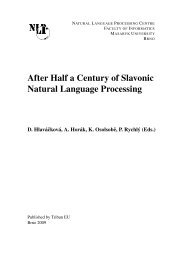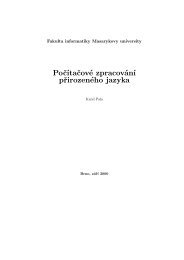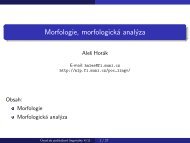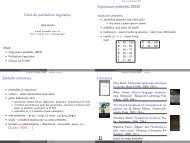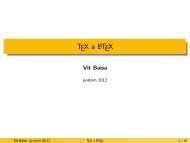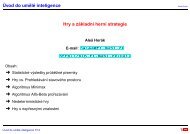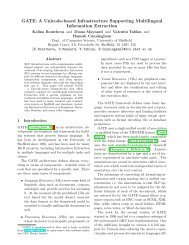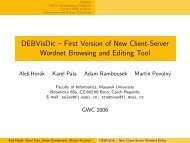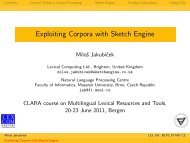Fast Morphological Analysis of Czech
Fast Morphological Analysis of Czech
Fast Morphological Analysis of Czech
You also want an ePaper? Increase the reach of your titles
YUMPU automatically turns print PDFs into web optimized ePapers that Google loves.
klouček:A,k1gMnSc1<br />
kloučka:Cek,k1gMnSc2<br />
kloučka:Cek,k1gMnSc4<br />
<strong>Fast</strong> <strong>Morphological</strong> <strong>Analysis</strong> <strong>of</strong> <strong>Czech</strong> 7<br />
the colon is a delimiter between the possible inputs and corresponding outputs<br />
and the letters A and C as the first and the third letters <strong>of</strong> the alphabet mean<br />
“to get the lemma delete n-1 (i.e. 0 or 2, respectively) last characters from<br />
the word form and then attach the rest <strong>of</strong> the string (i.e. empty string or ek,<br />
respectively)”. Then the word form klouček will be analyzed as a lemma klouček<br />
with a morphological tag k1gMnSc1 5 and a word form kloučka as a lemma<br />
klouček with morphological tags k1gMnSc2 and k1gMnSc4 6 .<br />
Such a list is then represented as a minimal deterministic acyclic finite state<br />
automaton using Jan Daciuk’s algorithms for incremental building <strong>of</strong> minimal<br />
DAFSAs [1]. This representation dramatically reduces the size <strong>of</strong> the data (some<br />
particular figures can be seen later in Table 2). The lookup is then very simple: if<br />
the analysed string concatenated with the delimiter is found in the automaton,<br />
then each possible remaining path to a final state <strong>of</strong> the automaton encodes one<br />
<strong>of</strong> possible analyses.<br />
It means that there is no “real” analysis as a sophisticated algorithm above<br />
some grammar model or a system <strong>of</strong> paradigms, but whole analysis is only a<br />
simple — and therefore fast — dictionary search.<br />
3 Performance Comparison<br />
Results <strong>of</strong> a performance comparison <strong>of</strong> the analysers ajka and majka are<br />
presented in the Table 1. The comparison was done on the first one million<br />
words from the SYN2000 corpus [7] which is a part <strong>of</strong> the <strong>Czech</strong> National<br />
Corpus 7 .<br />
Table 1. Results <strong>of</strong> comparison <strong>of</strong> the old analyser ajka and the new analyser<br />
majka<br />
size <strong>of</strong> data in MB time in seconds<br />
ajka majka ajka majka ratio<br />
morphological analysis<br />
4.4 18.22 2.88 6.3x<br />
lemmatisation<br />
all word forms<br />
3.1<br />
4.0<br />
6.1<br />
16.76<br />
55.33<br />
1.57<br />
8.42<br />
10.7x<br />
6.6x<br />
restoration <strong>of</strong> diacritics 3.3 8698.80 1.61 5403x<br />
The measured time is a “wall clock” time as was reported by a unix<br />
command time. All times are averages <strong>of</strong> three runs. Outputs <strong>of</strong> the analysers<br />
were allways redirected to /dev/null to measure only a CPU time and not<br />
waits for a hard disk etc.<br />
5 little boy in nominative form<br />
7 http://www.korpus.cz/english/<br />
6 little boy in genitive and accusative form



